So, this post actually serves two purposes. The primary one is contained in the header: it’s advice and what to expect when planning a trip dedicated to nature photography. But also, by way of example, it’s a continuation of the beach trip stories, the good and the bad, the Sturm und Drang (perhaps – I don’t actually know what that means since I don’t speak Italian.) But don’t let me ruin it for you – click to play, and wallow in my terrible podcasting habits..
Walkabout podcast – Photo trips
And naturally, some images to illustrate the narrative (or aimless ramblings or whatever you want to call it.) No skipping ahead now.
I mention a trip that resulted in having to do laundry in a motel room sink, and it’s a pretty exciting account, one that I actually posted about. How this alone hasn’t earned me fame and fortune, I’ll never know – maybe it’s just too unbelievable.
 This was sunset – what there was of it – at a little harbor in Avon. About all I could do was position myself to place that strange bump in the clouds over the tree to make it look like it belonged there. If you look close, you can see the faint shadow cast by that slightly taller cloud onto the humidity layer above, the kind of thing that makes sun rays (or crepuscular rays, if you want the technical term) in better conditions than this.
This was sunset – what there was of it – at a little harbor in Avon. About all I could do was position myself to place that strange bump in the clouds over the tree to make it look like it belonged there. If you look close, you can see the faint shadow cast by that slightly taller cloud onto the humidity layer above, the kind of thing that makes sun rays (or crepuscular rays, if you want the technical term) in better conditions than this.
If you’re extremely lucky, you’re right next to something photogenic when a gorgeous sunset occurs, but most times, you’re either someplace ugly and can’t provide any foreground interest, or you’re someplace interesting and scenic and the sunset refuses to perform. However, I strongly emphasize planning ahead, and knowing what place is going to look interesting if and when the end-of-day colors come rolling in, especially since they often don’t last very long and can change rapidly. It doesn’t always pan out, but it’s better to be prepared than to try and find someplace the looks nice when the sunset suddenly turns out to be stunning. You’ll have only minutes, and will likely miss it.
The perspective seen in this image was to the west, of course, and almost the only clouds visible in the sky. There was a small exception to the north, however.
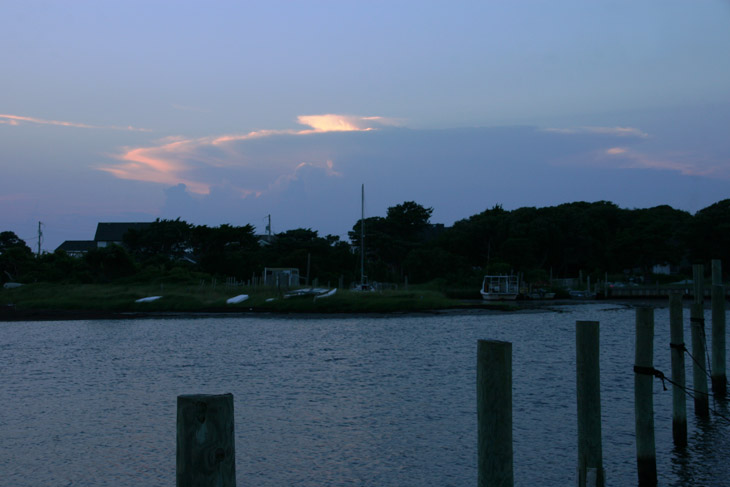 While waiting to see if the sunset might improve a bit, I was looking carefully at this anvil cloud well north of where I was, with a couple of rising cumulonimbus clouds in front of it. This kind of cloud formation will often result in thunderstorms, and the heat and humidity conditions of the day supported this possibility; it’s the same kind of thing that causes the frequent summer afternoon thunderstorms (I call them monsoons) in Florida. The sun hadn’t quite set at this time so the sky was still pretty bright, and I could see no actual lightning activity in the clouds, but wondered nonetheless. Traveling north was easy – there are really only two choices from Avon, north and south, unless you happen to have an amphibious vehicle, or wings of some sort. A hovercraft would do it too. But okay, most of us would have just two choices, and hitting NC 12 north would be taking me almost directly towards this distant cloud formation. I decided to chance it, since I had only one other thing planned for the evening, and I could do that just about anywhere.
While waiting to see if the sunset might improve a bit, I was looking carefully at this anvil cloud well north of where I was, with a couple of rising cumulonimbus clouds in front of it. This kind of cloud formation will often result in thunderstorms, and the heat and humidity conditions of the day supported this possibility; it’s the same kind of thing that causes the frequent summer afternoon thunderstorms (I call them monsoons) in Florida. The sun hadn’t quite set at this time so the sky was still pretty bright, and I could see no actual lightning activity in the clouds, but wondered nonetheless. Traveling north was easy – there are really only two choices from Avon, north and south, unless you happen to have an amphibious vehicle, or wings of some sort. A hovercraft would do it too. But okay, most of us would have just two choices, and hitting NC 12 north would be taking me almost directly towards this distant cloud formation. I decided to chance it, since I had only one other thing planned for the evening, and I could do that just about anywhere.
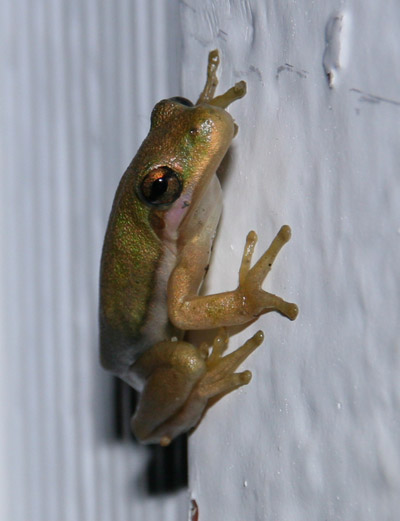 I cannot, to no one’s surprise, neglect my normal subject matter even when I’m on a trip specifically to produce more scenic and landscape photos than I can achieve in my normal haunts. When stopping to put air in a leaky tire, this very small green treefrog (Hyla cinerea) was startled from its perch near the air hose, so I grabbed the camera and got just a couple of frames. It was getting much darker by this time and I was on the shady side of the building, so I had to focus by the light of a penlight held in one hand, which is a trick all in itself, one that I’ve had to do far too often – one hand holds the camera, while the other supports and focuses the lens, so a couple of spare fingers in there must not only hold the light, they have to aim it where the lens is pointing at the same time. If you haven’t tried this yet, you simply must.
I cannot, to no one’s surprise, neglect my normal subject matter even when I’m on a trip specifically to produce more scenic and landscape photos than I can achieve in my normal haunts. When stopping to put air in a leaky tire, this very small green treefrog (Hyla cinerea) was startled from its perch near the air hose, so I grabbed the camera and got just a couple of frames. It was getting much darker by this time and I was on the shady side of the building, so I had to focus by the light of a penlight held in one hand, which is a trick all in itself, one that I’ve had to do far too often – one hand holds the camera, while the other supports and focuses the lens, so a couple of spare fingers in there must not only hold the light, they have to aim it where the lens is pointing at the same time. If you haven’t tried this yet, you simply must.
If you have not yet reached the part of the podcast where I talk about insect repellent, you’re getting ahead of the story. Pause here and wait for me to catch up before scrolling further.
Because, you know, sometimes things just work out right.
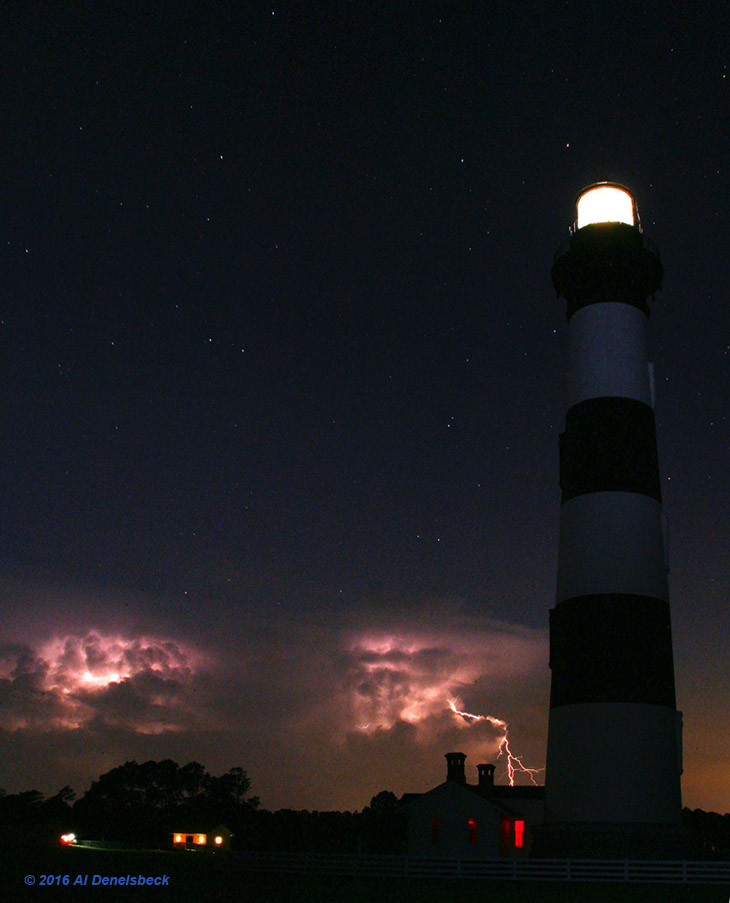
My biggest regret over this image is how badly the high ISO settings appear on this camera – that pebbly, textured look comes from shooting at ISO 640 to capture the dimmer light. I’m still quite pleased with this image (among many from that evening, actually) and am happy that the gamble paid off. I stayed only one night out there, and could have encountered numerous different conditions, most of which wouldn’t have produced anything of interest.
If you’re playing along with Google Earth, as mentioned previously, clicking here will load my precise position.
This is not the first time I’ve shot lightning at Bodie Island light, by the way – this image was shot almost 180° around the lighthouse and had been my previous favorite, even adorning one of my business cards (I have several designs, all photos,) while the one in this post was shot by the light of a full moon without the benefit of any storm activity. In fact, let’s compare another photo from that evening.

I switched positions a bit to reframe the storm and lighthouse, and got the setting crescent moon in the photo, as well as Jupiter above and to the left – the moon was too overexposed to show its shape. The first shot with the dramatic bolt was aimed northwest, while this one was aimed pretty much due west, but at 18mm focal length for both shots, the field of view is fairly wide. I will admit that this image is a composite, just for the record – the frame that captured the little lightning bolt peeking in here also had the lights from someone’s car illuminating one side of the lighthouse, so I dubbed in the lighthouse from another image that did not have this artifact, easy enough to do since I had numerous frames taken from the same position, camera atop the tripod of course. Both of the above images were taken with the addition of a single full-power pop from the Metz 40MZ-3i flash unit, held in one hand aimed more towards the top of the lighthouse to prevent the details closer to me, such as the ground and the fence, from being too brightly exposed.
Once I had donated enough blood to the mosquitoes (which coincidentally occurred about the time the storms were petering out, and where I wrapped up the podcast,) I packed up and headed back south towards my motel room in Avon, intending to stop along the way to do some night sky photography, one of my goals for this trip since the middle Outer Banks probably has the darkest sky conditions in the entire state. The spot I’d picked earlier in the day (again, planning for the upcoming conditions) is here in Google Earth, about seven kilometers south of the town of Salvo which, as noted previously, does not even have streetlights. The skies were indeed wonderfully dark, but other storms were developing that evening, and by the time I got the camera and tripod set up, patches of clouds were obscuring large portions of the sky and greatly limiting my choices.
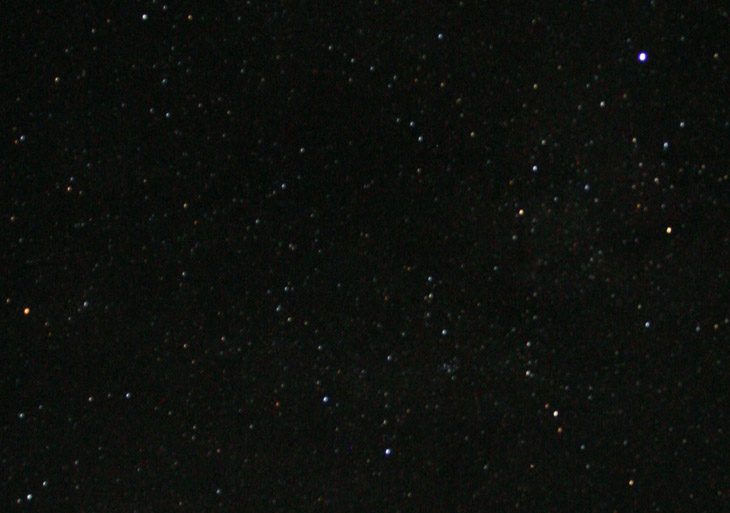
This is a crop from the larger frame shot at 24mm, f2.8, 23 seconds at ISO 1600 – none too shabby, even though focus could have been a little tighter. The bright star at upper right is Deneb, one of the ‘gateway’ stars that frame a small gap in the Milky Way high in the sky, easily seen by eye on dark nights. I will have to return to try and do more with these conditions.
Since there were more storms around, I spent some time trying to capture something dramatic from them, without a lot of luck; the lightning was too distant and usually obscured by low-lying clouds closer to me. It was also occurring in several directions, and every time something looked promising and I re-aimed the camera to take advantage of this, then another area outside of the frame would demonstrate something that I wished I’d captured. This can happen a lot with lightning photography, too. Below, one frame with two distinct flashes from almost the exact same position, captured at either end of a 55-second exposure.
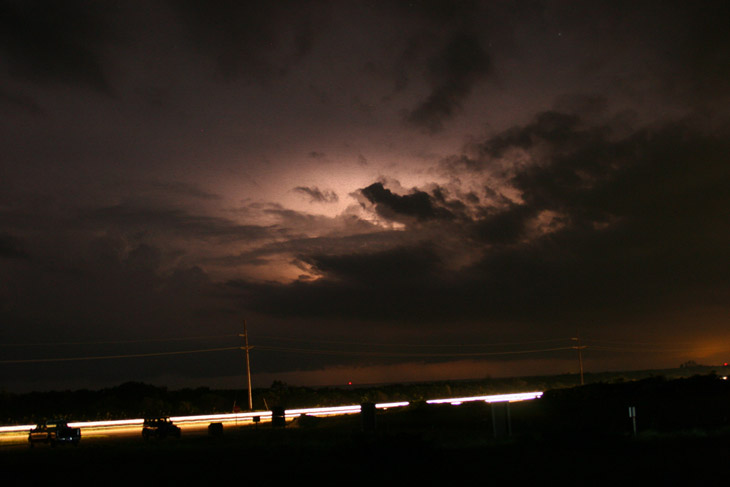
So what you’re seeing here is how much the clouds moved in under a minute, each lightning bolt illuminating the same clouds in different positions. The streaks are from traffic on NC 12, and you can see the high-tension power lines that run the length of the Outer Banks, well, because they have to. What’s impressive about this is how little the undersides of the clouds are lit up by ground lights, despite being quite low; where I live, the same conditions and exposure would have created a bright orange glow from reflected city lights.
And now, a cool comparison:
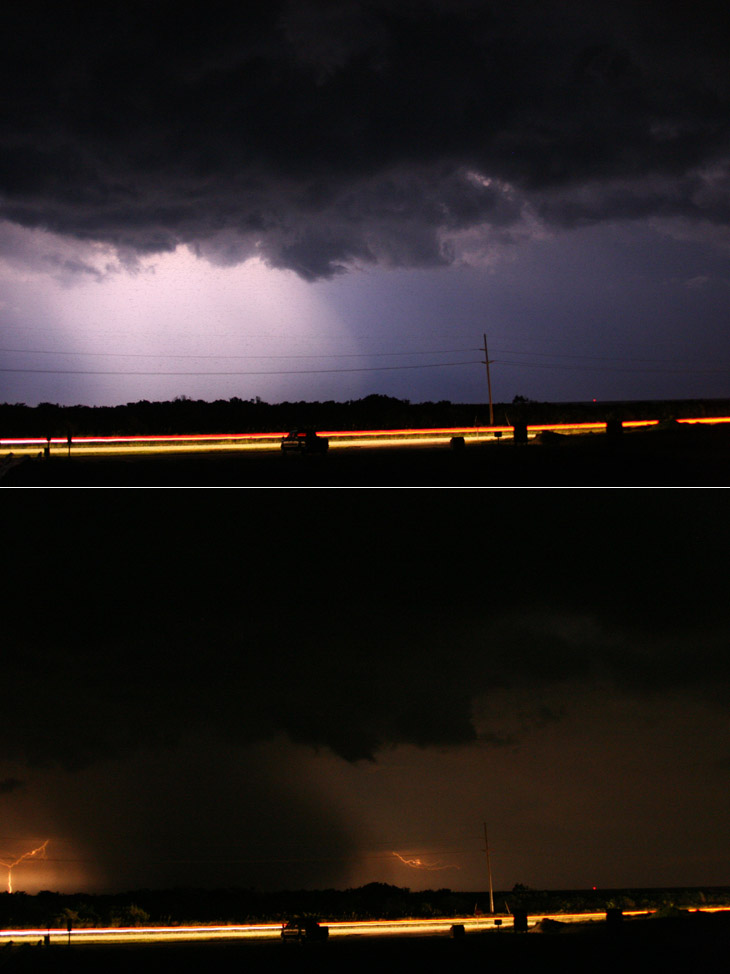
The top frame was from a brilliant lightning strike the lit up the whole area, but I hadn’t been looking at it right at that second and didn’t know if I’d captured a visible bolt – apparently not. The lower frame demonstrates why, even though two other strikes, much more distant, are easily visible. Time exposures reveal things that can’t always be discerned by eye, and in this case, it was the bank of approaching rain, framed between those two bolts in the lower image and obscuring(while being illuminated by) the brighter bolt in the upper. This was aiming largely west, out over Pamlico Sound, and so was showing an oncoming storm, albeit a local cell.
Shortly afterward, the wind began gusting so badly that I knew the tripod was not stable for long exposures, and I wasn’t seeing enough anyway, so I packed up the equipment again. Before I’d finished, I felt the first few drops of rain, and by the time I’d gotten back to the car (the parking area is vaguely visible in these images,) it was indicating that the rain would be starting in earnest. About thirty seconds after hitting the road back south, the horrendous downpour began, so my timing wasn’t bad at all.
But, all of that’s a good indication of how it goes. Some storms are great, some just don’t work out. Even preparation won’t guarantee results, though it greatly increases the probability; I could have driven north to the lighthouse only to have the storm die out before then, or never really develop at all. One of my planned items for this trip, the night sky shots, I didn’t really achieve except for proof of valid concept. Being flexible, however, helped me get something interesting anyway.



















































